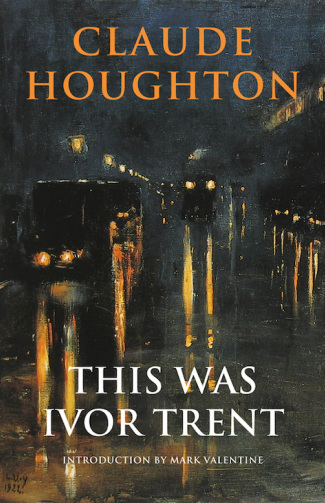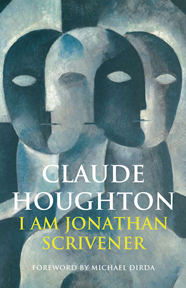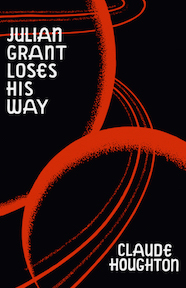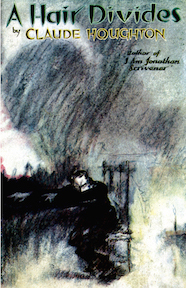|
BOOK DETAILS
Trade paper ISBN-13: 978-1939140111 List Price: $16.99 U.S. Pages: 244 Published: 2013 |
This Was Ivor Trent (1935)
Claude Houghton With a new introduction by Mark Valentine Book Description
One dark, foggy night, the eminent novelist Ivor Trent is on his way to a flat in a sordid London lodging house where he plans to begin work on his newest book, undisturbed by his friends, who all believe him to have gone abroad. On his way there, he glimpses a figure in the fog and is struck with terror when he realizes it is a man from the future. He collapses on the front step of the house, where the proprietor finds him, raving and delirious. Meanwhile, Arthur Rendell, a lonely widower who found solace in one of Trent's novels, determines to find out more about the writer and takes a room in the same house, where he meets Trent's friends, associates, and lovers. To Rosalie Vivian, Trent is a god; to Vera Thornton, he is a devil; to Denis Wrayburn, he heralds a new race of supermen. But who is Ivor Trent, really? And what is the explanation of the terrible vision he experienced in the fog? Rendell intends to find out, but he is unprepared for the devastating truth. Expanding on the themes first explored in his masterpiece I Am Jonathan Scrivener (1930) (also available from Valancourt Books), This Was Ivor Trent (1935) was a success in both England and America and was one of the best-known novels of Claude Houghton (1889-1961). Though admired by writers as diverse as P. G. Wodehouse, Henry Miller, J. B. Priestley, and Graham Greene, Houghton has fallen into neglect in the past half-century and awaits rediscovery by a new generation of readers. This edition is newly typeset from the first London edition and includes a new introduction by Mark Valentine. |
reviews
“Claude Houghton is leading the field in mental and intellectual stimulation with This Was Ivor Trent. I found it as thrilling and tantalizing as any crime story.” – Daily Mail
“Mental excitement runs through This Was Ivor Trent. It is not the same as the excitement aroused by incident, of which there is also no lack, but it is more thrilling and there is probably no one writing fiction today who can communicate it so well as Mr. Houghton can.” – The Scotsman
"An extremely interesting novelist, and a genuinely original one." - J. B. Priestley
"One of the most interesting and one of the most important novelists now writing in England." - Hugh Walpole
"At his best, he writes as well as any living man." - L.A.G. Strong
“Mental excitement runs through This Was Ivor Trent. It is not the same as the excitement aroused by incident, of which there is also no lack, but it is more thrilling and there is probably no one writing fiction today who can communicate it so well as Mr. Houghton can.” – The Scotsman
"An extremely interesting novelist, and a genuinely original one." - J. B. Priestley
"One of the most interesting and one of the most important novelists now writing in England." - Hugh Walpole
"At his best, he writes as well as any living man." - L.A.G. Strong
ALSO AVAILABLE THROUGH ONLINE RETAILERS
|
EBOOK
Kindle US |
MORE TITLES BY THIS AUTHOR
AUTHOR BIOGRAPHY

Claude Houghton Oldfield was born in 1889 in Sevenoaks, Kent and was educated at Dulwich College. He trained as an accountant and worked in the Admiralty in the First World War, rejected for active service by poor eyesight. In 1920 he married a West End actress, Dulcie Benson, and they lived in a cottage in the Chiltern Hills. To a writers’ directory, Houghton gave his hobbies as reading in bed, riding, visiting Devon and abroad, and talking to people different to himself. He added: “I like dawn, and the dead of night, in great cities.” He disliked fuss, noise, crowds, rows, and being misquoted, or being told how much he owed “to some writer I’ve never read”.
Houghton’s earliest writing was poetry and drama before turning to prose fiction with his first novel, Neighbours, in 1926. In the 1930s, Houghton published several well-received novels that met with solid sales and respectable reviews, including I Am Jonathan Scrivener (1930), easily his most popular and best-known work, Chaos Is Come Again (1932), Julian Grant Loses His Way (1933), This Was Ivor Trent (1935), Strangers (1938), and Hudson Rejoins the Herd (1939). Although he published nearly a dozen more novels throughout the 1940s and 1950s, most critics feel his later works are less significant than his novels of the 1930s.
Houghton was a prolific correspondent, generous in devoting his time to answering letters and signing copies for readers who enjoyed his books. One of these was novelist Henry Miller, who never met Houghton but began an impassioned epistolary exchange with him after being profoundly moved by his works. Houghton’s other admirers included his contemporaries P. G. Wodehouse, Clemence Dane, and Hugh Walpole. Houghton died in 1961.
Houghton’s earliest writing was poetry and drama before turning to prose fiction with his first novel, Neighbours, in 1926. In the 1930s, Houghton published several well-received novels that met with solid sales and respectable reviews, including I Am Jonathan Scrivener (1930), easily his most popular and best-known work, Chaos Is Come Again (1932), Julian Grant Loses His Way (1933), This Was Ivor Trent (1935), Strangers (1938), and Hudson Rejoins the Herd (1939). Although he published nearly a dozen more novels throughout the 1940s and 1950s, most critics feel his later works are less significant than his novels of the 1930s.
Houghton was a prolific correspondent, generous in devoting his time to answering letters and signing copies for readers who enjoyed his books. One of these was novelist Henry Miller, who never met Houghton but began an impassioned epistolary exchange with him after being profoundly moved by his works. Houghton’s other admirers included his contemporaries P. G. Wodehouse, Clemence Dane, and Hugh Walpole. Houghton died in 1961.





